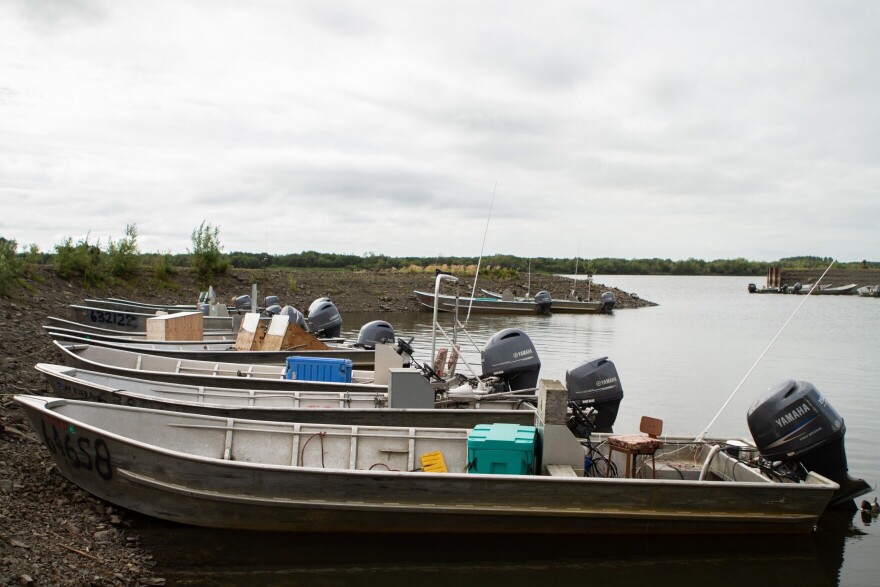Last year, the Yukon River saw unprecedented low salmon runs. Similarly dismal runs are forecast for this year. That could mean another season with no subsistence salmon fishing for communities where salmon is the primary subsistence food source. However if subsistence salmon fishing is allowed, then new restrictions will take effect along much of the river, limiting who is eligible to fish.
“From the fisherman’s standpoint, this summer is going to be horrible. It’s the second year in a row where there could potentially be no salmon fishing,” said U.S. Fish and Wildlife Service Yukon River Fishery Manager Holly Carroll.
The restriction on fishing could cover not just the summer season Chinook and summer chum runs, but also the fall chum and coho runs.
“And that’s incredibly unusual on the Yukon. Normally our chum runs are in the millions. So to have two years in a row with no salmon harvest predicted, this is going to be a huge loss of food and traditional practice,” Carroll said.
Last year the Yukon River saw its lowest ever chum and coho runs, and one of its lowest ever Chinook runs. To conserve what few salmon might return this year, two tribes, the Holy Cross Tribe and the Native Village of Eagle, along with two Yukon River residents, requested federal management of the Yukon River.

The Federal Subsistence Board approved the request. As a result, the federal government will manage the Yukon River salmon fishery this summer within federal waters. And within these waters, only rural residents who live along the river will be allowed to fish for salmon.
This restriction to local users is allowed under the Alaska National Interest Lands Conservation Act. When there is a conservation concern of a resource, like salmon, this federal law has a chapter that can be used to limit the resource to local users who have a traditional and customary history with that resource.
“We are managing these runs to preserve them for sustainable uses, but also to preserve cultural practice and for subsistence priority,” Carroll said.
Similar regulations have existed in the federal waters of the lower Kuskokwim River for nearly a decade. But this is the first time subsistence salmon harvest within the Yukon River federal waters will be limited to local users. That is, if subsistence harvest is even allowed.
“Fingers crossed. We hope there could be. Of course, the runs are so poor that we would have to see the runs come in at the top of the projection for either Chinook or summer chum to even allow any targeted salmon fishing,” Carroll said.
To allow this fishing, the runs would first need to indicate that there are enough salmon to meet escapement goals, both for the state’s goals and for the treaty goals with Canada. Carroll said that information won’t begin to clarify until at least the mid-point of the Chinook run in the lower river, usually around June 24.
If there are enough salmon to allow for subsistence fishing, then only people who live along the river will be allowed to fish for salmon in federal waters. Much of the Yukon River is federal water because it passes through federal lands.
This includes the first 250 miles of the lower river, from the mouth upstream to Paimiut, because it is within the Yukon Delta National Wildlife Refuge.
It’s customary for people who grew up in the region or have ties to the region and have moved away to return to fish for salmon with their families. But if fishing opens, this would be different this summer. Only permanent rural residents can fish for salmon in these federal waters, but there are still ways for family members to help.
“They can help in fish camp. They can help carry fish to the smoker from the boat. They just can’t actively take the [salmon],” Carroll said.
That means no driving the boat, throwing the net, or picking the net. But they can still share in the harvest.
“If they typically get a portion of their family’s typical harvest, that can still occur,” Carroll said.
Carroll knows that this restriction on family members is a concern. She said that she will be talking with tribes and fishermen to understand the full extent of how this restriction affects subsistence users.
This restriction will not apply to state waters. Any Alaska resident can fish in state waters if the river opens to subsistence, and that’s a big if. With subsistence fishing in question, sport and commercial fishing for salmon will not be allowed on the Yukon River this year. Under federal and state law, subsistence is the first harvest priority.
Because there might be no salmon fishing, Carroll is planning to allow for abundant fishing for non-salmon species.
“There are sheefish. We have many different types of whitefish, so humpback, round, broad whitefish. There’s cisco. There’s burbot. There’s pike. Some people will rod and reel for grayling,” Carroll said.
This fishing for non-salmon will be open to all state residents using four-inch mesh gillnets, 60 feet in length.






